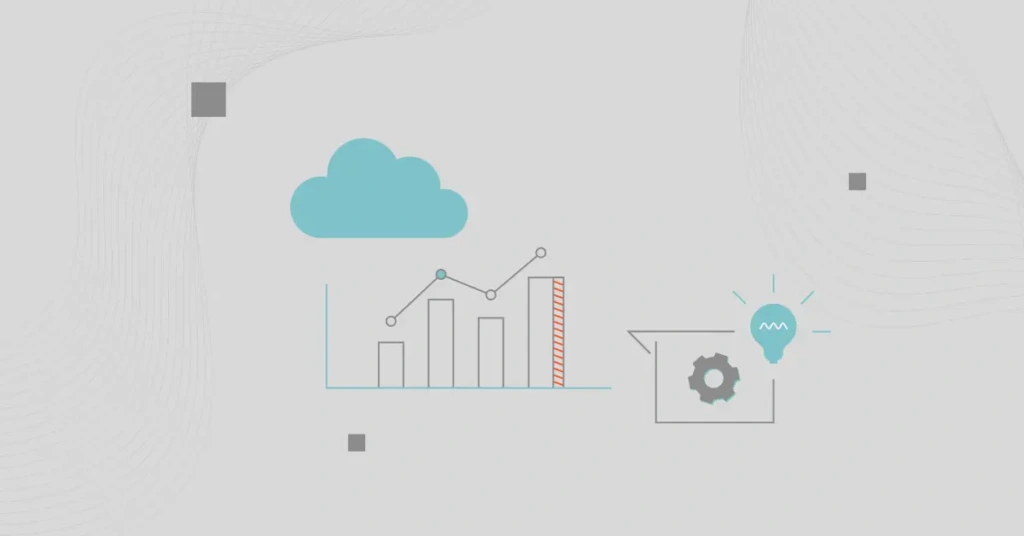Businesses are increasingly interested in cloud economics. For instance, what are the financial implications of moving to the cloud versus staying on-premises? And what’s the best strategy for optimizing cloud consumption to get the best value from cloud resources?
In this guide, we’ll look at some of the key concepts of economics in cloud computing, and how your business can leverage cloud cost intelligence to maximize the value of your cloud investment.
What Is Cloud Economics?
Cloud economics is the study of the benefits, costs, and principles of cloud computing. It involves understanding the total cost of ownership (TCO) of cloud computing, the benefits of the cloud over on-premises models, and cost optimization strategies that will maximize ROI on your cloud investment.
Cloud economics is not just about costs in actual monetary terms. It is also about the opportunity costs of the cloud, the peculiarities of managing costs in a highly dynamic environment, and practicing cloud cost optimization best practices.
Here are a number of powerful reasons for understanding the economics of cloud computing for your organization.
7 Key Benefits Of Understanding Cloud Economics
The top advantages of practicing the discipline of cloud economics range from reducing cloud costs to understanding exactly where to increase investment to maximize ROI of the cloud.
Consider these:
1. Cloud economics helps you identify the economic benefits of the cloud
A thorough cloud economics analysis helps make a business case for migrating from on-premises infrastructure to the cloud.
See, it’s tempting to hop onto the digital transformation bandwagon because it is “the new normal”.
Also, it is easy to assume the benefits of cloud computing, including on-demand scalability, disaster recovery, and faster time-to-market, will automatically lead to increased revenue or IT cost savings.
But as a business, you need to do a cost-benefit analysis before moving workloads to the cloud. Pursuing this data can help you:
- Have a clear business case for moving to the cloud, including what metrics and KPIs to use to measure your progress and performance over time.
- Measure the risk-reward involved in operating in the cloud vs on-premises.
- Decide what makes more economic sense to your organization, for example, using lift and shift migration or refactoring applications to become cloud-native.
- Help you decide whether to move all workloads to the cloud, or what areas to prioritize, and if you should migrate a portion of it at a time or all at once.
It can also help you avoid resistance to change or confirmation bias (letting pre-existing notions distort judgment about the economics of cloud computing).
2. Cloud economics analysis encourages you to evaluate your Cloud Total Cost of Ownership (Cloud TCO)
You can answer other crucial questions by analyzing your cloud economics. For example, how could cloud computing impact our cost of goods sold (COGS)?
Simply putting this question into focus can help shape your cloud strategy and how to execute it, including which cloud service provider and the specific cloud services to use and why.
For example, will the change require new people, training, and skills to support core services? And who will be responsible for tracking our cloud economics metrics so we can tell if we are moving closer to our goals or not?
We talk more about TCO in the section below.
3. Cloud economics calculations are the basis for cloud cost optimization
Like with anything else, measuring your results enables you to stare right at what’s working and what needs to improve. Yet, pinpointing what areas to cut back on and which ones to increase investment in can be challenging without the right information.
For example, according to a PwC survey, 51% of business leaders are unclear on how to measure cloud ROI. Different organizations use different parameters.
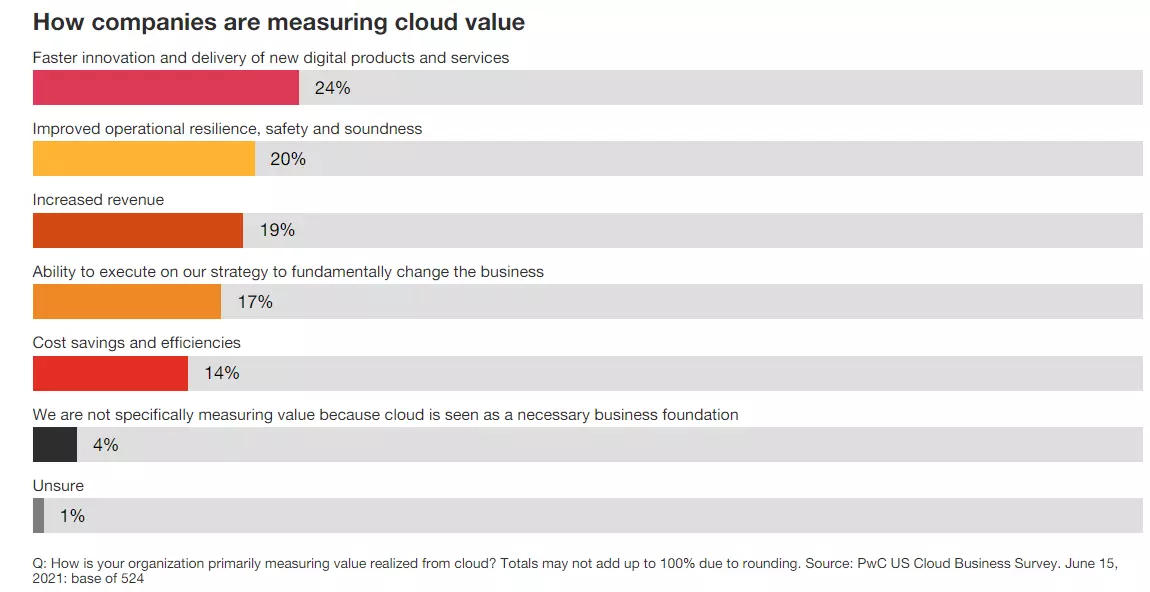
Credit: PwC Cloud Business Survey findings
As you can tell, without a measurement strategy, many of these parameters are hard to justify in everyday operations.
Practicing cloud economics best practices can help you alleviate this problem by quantifying these goals. For example, you can:
- Use unit economics: Analyzing metrics such as your cost per customer, the cost to develop a new product or feature, and even cost per engineering team empowers you to understand who, what, and why your cloud costs are changing (so you can actually do something about it). Picture this:
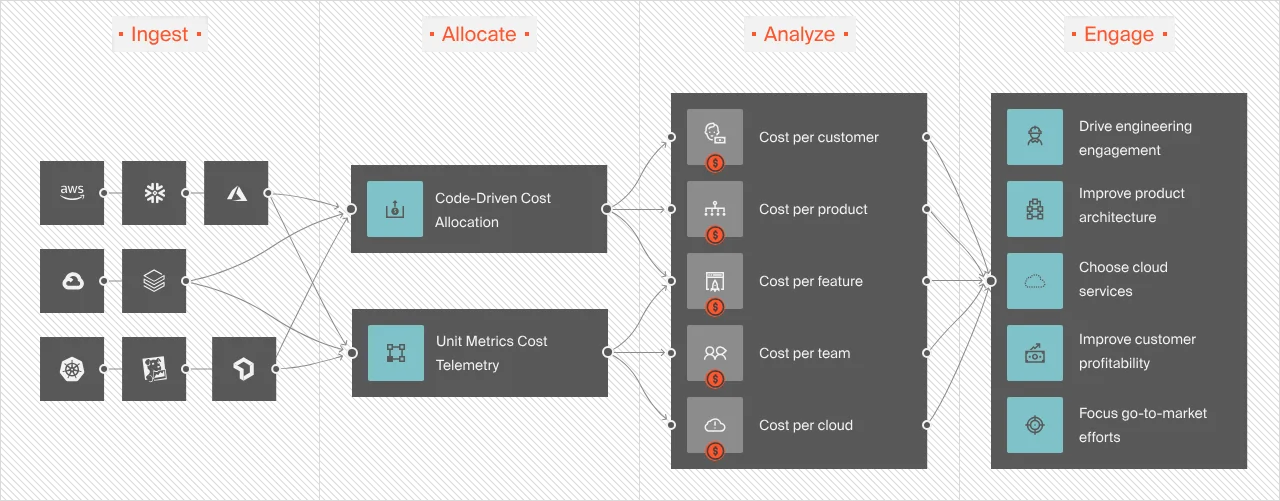
- Find cost saving opportunities in the cloud: By pinpointing the people, products, and processes driving your costs, you can decide where to cut back to protect your margins and where to invest more to maximize ROI — without compromising engineering velocity, system performance, or customer experiences.
- Bring in quality investors: Gross margin analyses and COGS evaluations play a major role in SaaS company valuations. They are key indicators of SaaS health and profitability. So, once you have your cloud economics at hand, you can more easily justify competitive market valuations and favorable financing.
Why Is It Important To Consider Cloud Economics In Business And Engineering Decisions?
Understanding cloud economics is key to making smart business and engineering decisions. Here’s why it matters so much for both strategy and day-to-day operations:
1. Strategic alignment and cost transparency
Cloud economics helps align cloud investments with business goals. The alignment is achieved by looking into cost transparency. Engineers can see direct and indirect cloud operation costs clearly.
Insights help budget and invest efficiently, focusing on high ROI areas. This supports goals like market expansion or product innovation.
2. Enhancing innovation and agility
Cloud economics empower engineering teams to innovate quickly and precisely. Teams can choose wisely by assessing the financial effects of different cloud services. This helps balance cost with performance.
Ability to innovate within a cost-efficient framework encourages innovation and rapid development. This is crucial for staying competitive and reaching innovation goals.
3. Optimizing resources for maximum efficiency
At the core of cloud economics is the principle of maximizing resource efficiency. Organizations can optimize cloud resources with cloud economics.
This optimization boosts cost savings and helps the organization respond to market demands. It also improves operational efficiency and resource allocation for strategic growth initiatives.
4. Driving sustainable growth
Cloud economics principles help businesses scale cloud infrastructure economically and strategically. Companies making informed decisions on cloud spend management can allocate resources for innovation.
This helps them deliver value to customers and establish a solid foundation for sustainable growth. The strategic cloud spending approach ensures growth targets are met. It also maintains financial stability and operational efficiency.
Understanding Cloud Economics: Key Areas To Consider
If you want to become a success story like many cloud zero customers, start by understanding these cloud economics essentials.
1. Cloud total cost of ownership (TCO)
In cloud computing, the total cost of ownership (TCO) is the total cost of adopting, operating, and provisioning cloud infrastructure. TCO is helpful for understanding your return on investment.
Businesses have always performed TCO analysis for traditional IT infrastructure. However, performing TCO analysis for cloud computing can be challenging because the environment is inherently more complex and dynamic than on-premises environments.
Getting an accurate TCO for cloud computing means capturing the purchase price of on-premises vs. cloud solutions as well as the intangible costs of either solution. In practice, this means:
- Calculating the cost of your current IT infrastructure
- Estimating the total cost of cloud adoption (including migration costs)
- Quantifying the intangible benefits of the cloud (read our step-by-step guide for calculating cloud TCO to learn more here.)
The overall goal is to achieve a lower TCO compared to on-premises infrastructure, but it can also be about justifying a higher TCO by listing the intangible benefits associated with the cloud, such as agility and greater speed to market.
2. CAPEX to OPEX switch
Cloud computing uses a different pricing model from traditional computing and this affects how businesses account for cost. The move from capital expenses (CAPEX) to operating expenses (OPEX) is a key difference, and it affects how businesses gauge profitability in the cloud.
In traditional IT environments, computing costs are predictable and relatively fixed. A business pays for the computing capacity it needs upfront and uses the capacity over time.
Calculating the total cost of ownership in this setup is fairly straightforward. In contrast, cloud providers adopt a pay-as-you-go model and most services do not require any upfront commitment.
The implication is that your business will have variable cloud computing bills that depend on the services you use and how they are consumed. While this model may save your business upfront capital expenditure, it can become a huge financial suck if resources are not managed properly.
When moving to or operating in the cloud, it is important to develop and implement cloud cost optimization strategies that will help regulate your cloud costs. For example, CloudZero’s cost intelligence platform helps you track the cost of migrating to AWS and thereafter provides insights that help you reduce your AWS bill.
3. Elasticity
With on-premises systems and traditional IT environments, there’s a cost associated with anticipating demand.
Traditional IT environments are built to anticipate peaks, which means you buy and maintain excess computing capacity in anticipation of those peak days.
For most businesses, that’s a significant cost for something that’s rarely — if ever — used.
Cloud computing eliminates the need for over-provisioning because you pay only for what you use.
Cloud computing platforms, such as AWS, dynamically allocate resources to projects and processes, ensuring that a business has the right amount of resources it needs at any given time. This increases cost efficiency and allows businesses to optimize resource usage.
This elasticity is one of the most appealing aspects of cloud computing and a major selling point when making a case for switching to the cloud.
4. On-demand pricing
On-demand pricing is a fundamentally different economic approach to computing power. Outside of the cloud, you’d buy a fixed amount of computing capacity or a physical server that you own.
But in the cloud, you switch to on-demand pricing, so your costs increase or decrease with your usage in the cloud (they become elastic).
This means cloud costs can quickly spiral out of control if you are not monitoring them regularly and making data-driven decisions. The fall of 2018 is a case in point where Adobe engineers forgot to terminate a job on Azure, racking up $80,000 a day and over $500,000 in one week.
The Concept Of Cloud Cost Intelligence
One of the key things to remember when moving to the cloud is that a lot of people will be involved in cloud economics who may not necessarily be in core finance departments.
In classic IT infrastructure and computing, only a few people were involved in the economics of computing, including IT hardware people, who were responsible for creating the infrastructure, and finance personnel who approved those expenses and managed budgets.
In the cloud, many decisions that impact cloud cost are made outside of finance and IT teams. These include:
- Engineers, who decide which services to use to deliver software
- The product team, who decides how to price the licensing for software
- The marketing team, who determines product-led growth strategies
At CloudZero, we believe that economic success in the cloud requires that everyone in a company understands their contribution to cloud costs in their part of the business.
Cloud cost intelligence is about democratizing cost knowledge so everyone is empowered to maximize the benefit of the cloud.
Businesses that employ cloud cost intelligence are more likely to succeed in optimizing cloud costs because they:
- Have a good understanding of how their cost structure is different in the cloud compared to a non-cloud environment.
- Ensure that engineers and all relevant participants understand this difference.
- Give all relevant stakeholders visibility into how their workloads affect cost so everyone can collectively make good decisions that lead to higher profitability.
Understanding AWS Cloud Economics With CloudZero
Here’s CloudZero CTO and Co-Founder, Erik Peterson, to share some insights about cloud economics and more.
When relevant stakeholders don’t have access to cost knowledge, it’s difficult to get a grip on costs. That’s where CloudZero comes in. While some cloud provider tools provide this:
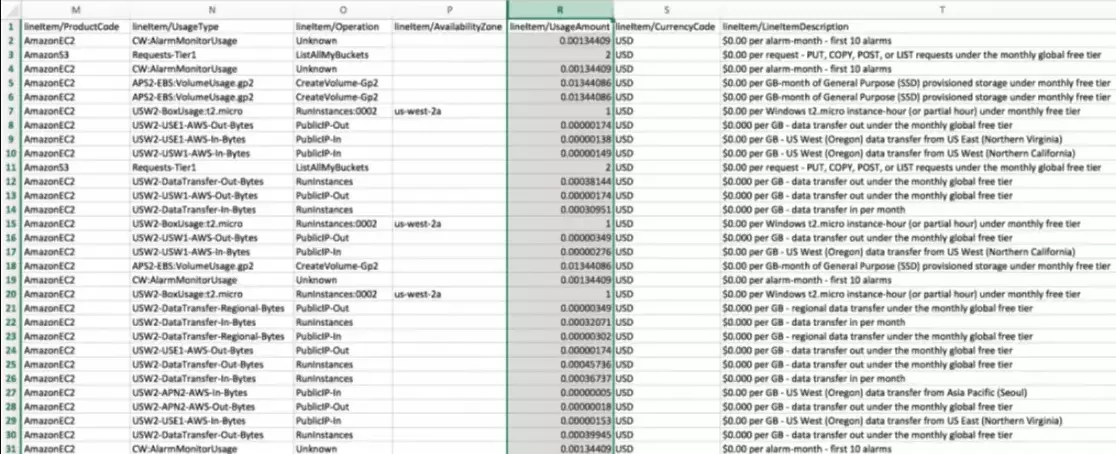
CloudZero delivers real, per-unit costs intelligence like this:
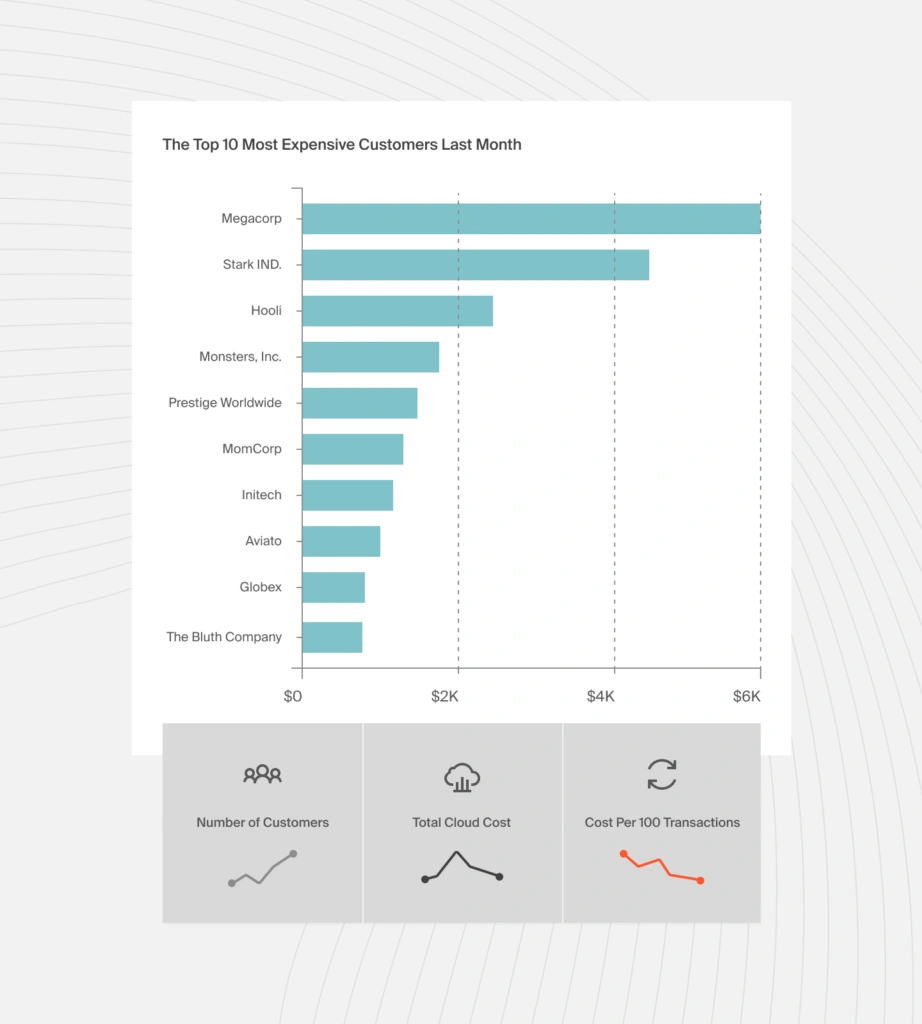
CloudZero’s cost intelligence platform helps you understand your cloud unit economics by aligning your cloud costs to key business metrics, such as cost per customer or product feature.

This data can be distributed to respective teams without giving people access to the master billing account.
Our customer Malwarebytes provides an excellent example of cloud cost intelligence at work. Before adopting CloudZero, the company had already been taking steps to track and manage costs, including implementing an aggressive tagging policy and using a cost management tool that allowed the DevOps team to report on their AWS bill.
The problem was that they were spending up to 10 hours a week drilling into reports and communicating with various teams to help them understand their cloud spend.
CloudZero made it possible for them to attribute AWS costs to specific products and decentralize cost management. DevOps immediately gained granular visibility into their cloud spend and could confidently explain their AWS expenses to the executive team.
The best part: The engineering team also became more cost-conscious and now had the ability to make informed decisions about the products they were building. As a result, Malwarebytes is now better positioned to optimize its cloud costs going forward.
To learn more about how the CloudZero cost intelligence platform can provide deeper insight into cloud cost economics at your company,  .
.
FAQ: Understanding Cloud Economics
What are the 4 pillars of a cloud value framework?
A cloud value framework has four pillars: Cost Savings, Staff Productivity, Operational Resilience, and Business Agility. These pillars help organizations measure and realize the full value of cloud allocation. The benefits go beyond cost savings.
What is a cloud economist?
A cloud economist specializes in managing and strategically aligning cloud spending with business objectives to optimize costs and maximize value. They leverage insights to guide financial decisions in the cloud.
Which cloud model is most economical?
The best cloud model depends on business needs and usage patterns. Hybrid cloud models merge public cloud flexibility with private cloud control and security. This combination offers cost efficiency.
What is the difference between FinOps and cloud economics?
FinOps operationalizes cloud financial management. It creates cost accountability among teams using cloud services. Cloud economics is broader. It includes studying economic principles behind cloud computing. This involves cost optimization, value realization, and financial decision-making.
What are the economic benefits of cloud services?
Cloud services offer economic benefits such as lower CapEx and operational costs. They also provide improved scalability, flexibility, and business agility. Additionally, users can access advanced technologies without large upfront costs.

